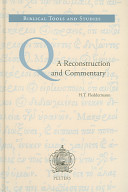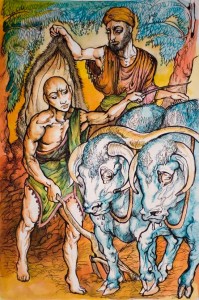Thomas Brodie argues that the Gospel accounts of Jesus, both his deeds and teachings, are like other literature of the era insofar as they are creative re-writings of earlier literary sources. The best known example of such creative imitation in the classical world is Virgil’s use of Homer’s epics to create the Aeneid. What is less well known is how pervasive this sort of literary imitation (and creative emulation) was in the Hellenistic and Roman worlds. Many scholars have pinpointed isolated passage in the Gospels that appear to be derived from other literature (e.g. Jesus raising the daughter of Jairus is very like similar miracles by Elijah and Elisha) but Brodie goes well beyond these arguments and into a quite different dimension of literary analysis, as I will explain below. He also argues that the hypothesis that the Gospels are derived from oral traditions is flawed for many reasons.
No-one who has read Thomas Brodie’s Beyond the Quest for the Historical Jesus: Memoir of a Discovery can can ever legitimately accuse Brodie of resorting to “extreme parallelomania” in order to argue his case. Indeed, scholars as reputable as Charles H. Talbert and Wilfrid Cantrell Smith found Brodie’s thesis to be worthy of wider serious consideration. Anyone who dismisses his arguments as even at times stooping to superficial dot-point comparisons of prepositions was never paying attention to what they claim they read. (I have suppressed the name of the prime culprit in order to protect the guilty.)
In Chapter 7 of Beyond the Quest Brodie gives a 26 page detailed explanation of what is involved in identifying the source of Luke 9:57-62 in 1 Kings 19. Six of those 26 pages set out in small font the relevant Greek texts and translations side by side. This is the sort of detail that Brodie explains he did not have space to include in his 2004 tome (680+ pages) identifying the sources of New Testament writings, The Birthing of the New Testament. But of those 680+ pages Brodie only gave a 6 page explanation of how those six verses are derived from 1 Kings 19. In Beyond the Quest we are treated to the full course banquet.
Getting Inside What Is Happening
Studies of how ancient writers adapted or transformed older texts, especially of how the New Testament used the Old Testament, are now becoming commonplace, but it is useful to look at an example closely because the transforming process can seem strange. (Beyond, p. 51)
Is Brodie suggesting that a simplistic spotting of supposedly parallel words (even prepositions) is becoming commonplace in the academy? If so, what can he possibly mean by a “transforming process”? What is it about supposed ancient literary mimesis that might “seem strange”? Aren’t we talking about a subjective Rorschach test, identifying shapes in clouds, bizarre parallelomania? That’s what Dr McGrath wants readers to think. He even tells them to read Brodie’s book after telling them that these are the glasses through which they must see it if they are to maintain his respect.
But how does ancient mimesis really work and how can modern scholars detect possible instances and then, most importantly, how can they test and verify them?
Firstly, Brodie analyzes the passage in Luke as a literary composition. The structure of the passage is identified.
Brodie continues:
As often happens in crafts, or sports, or sciences, or relationships, patience is necessary to get inside what is happening.
In case you’ve forgotten, have another look at the previous post to see what Brodie means by “patience”. Look for the header “It needed patience, patience, patience.”
To begin with, the context is established. Luke 9:51 to Luke 10:20 is subjected to a detailed literary analysis. The structure of this passage, it’s divisions of thought and motif, begin to bring a reader into the mind of the author. What was the author doing as he wrote this passage? He wasn’t just telling a story; he was structuring the events, the dialogues of questions and answers, in a crafted presentation.
Comparisons with a shorter version in Matthew 8:18-22 are recognized. The input of the Q hypothesis is considered and added to the mix of analysis.
Wider scholarly publications on this passage are consulted: in this case special attention is given to Fleddermann’s Q: A Reconstruction and Commentary. Fleddermann appears to identify something (this is me talking here, not Brodie) that would be called a “flag” — a signal to readers to identify the source-text. That is, Fleddermann (as Brodie acknowledges) has concluded that in the Lukan passage Jesus’s reference to taking the plough and not looking back has significant similarities with Elijah’s call of a young ploughman (Elisha). There are other connections, too, such as Lot’s wife being instructed not to look back.
A possible source text, 1 Kings, is similarly analyzed. What is it’s structure? Of what themes does it consist? And how are these pieced together? Do scholars acknowledge that 1 Kings 19 is truly a literary unity? If not, why not? How does the final product read?
In this case the identity of 1 Kings as a possible source text since in both larger passages there is reference to fire coming down from heaven and to setting out on a new journey. What that possible connection is, however, is by no means obvious.
How do the two texts compare? That is, not how might they be framed as similar, but setting out the key thoughts of each, what happens when those thoughts in those structures are set side by side? Is there a literal match? a conceptual match? a kind-of funny cloudy match? a non-match? Let it all fall where it will.
Anyone impatient to find fault with a “mythicist” would not bother with any of this detail. I imagine he would skip it all and look for something damning. Contrary evidence would be of no use. Evidence that refutes the “parallelomaniac” perception will not compute in the mind of such a reader. It will be impatiently dismissed.
Brodie concludes this section of his analysis:
Like a patient shipbuilder who draws on models of older craft, and who shapes details with the patience and precision of a watch-maker, or like a literary Michelangelo who combines mastery of an grand scale with equal mastery of detail, Luke has made several adaptations. These adaptations are of two main kinds: general and detailed. This division is not watertight; some general features involve details. The general adaptations involve five features:
- repetitive structure,
- content,
- plot,
- interweaving,
- and context.
(Beyond, p. 53, my formatting)
Brodie observes that the pattern of brief exchanges with Jesus (question and pithy-replies to would-be disciples) was earlier found in exchanges with John the Baptist in that Gospel, and that both occur at the beginning of a new ministry or just after a major turning point that leads to a new ministry. (Such an observation indicates, to me at least, authorial artifice at work.)
Brodie then comments on some very common words. Are such words enough to establish a connection, as McGrath wants readers of his review to believe? Here is Brodie’s thought:
In these introductions, most of the words (he said, to him, Lord) are so common that they cannot help in establishing any literary link between Luke and 1 Kgs 19.4-21. And the occurrence of . . . a form of ‘but’, especially . . . ‘but he said’ (59 times in Luke’s Gospel), is typically Lukan. (p. 54)
When Brodie does examine points in common it is not single words but syntactic structures and the patterns of their location in the run of larger thought-forms, their relative frequency in the totality of Biblical literature (p. 66).
I cannot reproduce the detailed complexity of Brodie’s arguments here. But here is his conclusion of his discussion of the introduction of the Lukan passage on page 69 (my formatting):
What is essential is that, in the first exchange, every element of Luke’s text, from the opening reference to journeying on the road to the final mention about laying down one’s head, comes either from
the scene of Elijah’s journey to Horeb
or from elements associated with it
or from Luke’s own vocabulary.
Ask, then, what room is there for any genuine words or action of an historical Jesus here?
As I said, it is beyond reasonable expectation for me to reproduce the detail of Brodie’s argument. So I will quote here the conclusion of his three page analysis of the next section, comparing Luke 9.59-60 with 1 Kings 19.9-18:
In summarizing Luke’s second exchange (Lk. 9.59-60) what is essential is that virtually every element in it is either a copy or variation of 1 Kings 19 or is a reflection of Luke’s own distinct vocabulary. (p. 71)
And then on the third section, comparing Luke 9.61-62 with 1 Kings 19.19-21:
Luke is not just playing with linguistic trivia. He is keeping elements of the passing on of the mantle of prophecy. Elisha burned the plough to stay with the mantle, but in Luke’s account of the call, the new mission still keeps the plough — as a metaphor, an indication of future fruitfulness and clear focus. . . .
Again, in the third exchange, virtually every elements of Luke’s text (9.61-62) is either a repetition/variation of 1 Kings 19 and related material or reflects Luke’s own distinctive vocabulary. (p. 73)
The metaphorical extraction from literal scenes in a source document reminds me (these are my own remarks here, not Brodie’s, though he would probably concur with them) of several passages across Virgil’s imitation of Homer and developments of his own imagery. Physical prowess in the source text is surpassed by matching spiritual superiority in the imitating text; a thunderstorm with deadly lightning at the beginning of an epic is matched by a spear thrust that strikes “like lightning” at the end.
Let Brodie take over now by way of conclusion (my bolding):
The opening of Elijah’s journey proper, the beginning of his journey in the wilderness (1 Kgs 19.4), provides immediate encouragement. Its eight opening words contain variations on all six of the opening words of Luke about the journey of Jesus (Lk. 9.57).
Further investigation shows wide-ranging similarities and adaptations. The form used by Luke, that of three pithy repetitive exchanges, follows a form that he himself had used earlier in reporting John’s replies to would-be doers (Lk. 3.10-14); and these exchanges also incorporate some of the repetitiveness of 1 Kings 19. Both 1 Kings 19 and Lk. 9.57-62 are essentially three-part, but in both cases the central part is more sharply challenging and . . . more elaborate. The heart of both texts is a variation on the call of the Old Testament prophets. In addition, Luke turns elements of plot, actions described as really happening, into metaphors: not being allowed to stay lying because of food at one’s head becomes not having a place to lay one’s head; emphasis on the dead becomes partly a metaphor for the spiritually dead; God appointing kings becomes a basis for referring to the kingdom of God; and ploughing turns into the metaphor of the plough. In addition, Luke interweaves the use of 1 Kings 19 with the use of other texts, and he adapts the final shape of the text to his own context. . . . .
Continued analysis shows similar procedures in the full detail of Luke’s work. Even the repetitive use of indefinite pronouns to indicate Jesus’ interlocutors, ‘someone’, ‘another’, ‘another’ (9.57, 59, 61), consists of repeating and varying the indefiniteness of the ‘someone’ who first speaks to Elijah in the wilderness (1 Kgs 19.5).
Likewise regarding the content within the framework. Essentially every word, every image of the entire text of the triple challenge is built either on the LXX (on 1 Kgs 19 plus associated references) or on Luke’s distinctive vocabulary and purpose. Occasionally Luke’s distinctive vocabulary has curious affinities with the Epistles . . . . .
At times Luke may seem to reflect material from another source, for instance in referring to the foxes and birds, but these animals fit perfectly with the image of the wilderness, and with other Septuagintal references to foxes and birds . . . . Even unusual words, such as ‘permit’, ‘say goodbye/take leave of’, and ‘worthy’ . . . . reflect Luke’s distinctive vocabulary (Fleddermann 2005: 396).
The Conclusion
The result of these procedures is that the sub-text, 1 Kings 19, is not just edited or redacted. It is transformed. Redaction is indeed present in the composition of the Gospels . . . but as the critique of John Van Seters (2006) has partly indicated, the role of redaction in composing the Bible has been exaggerated.
The role of redaction has been particularly exaggerated in discussions of Q. Since Matthew and Luke used redaction in dealing with Mark there is often a presumption that they also used redaction in dealing with their other sources. . . . .
There is no ready indication as to which texts are redacted and which are transformed. Each text has to be tested. In the case of Lk. 9:57-62, the transformation of the LXX . . . is the simplest explanation of the data . . . . In this case, Q is unnecessary, and therefore unjustified. (Beyond, p. 75)
Also unjustified, by implication, is the hypothesis that Luke’s narrative owes anything to oral tradition derived from historical events.






